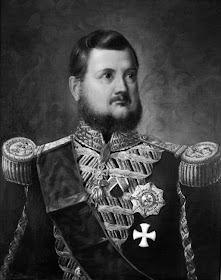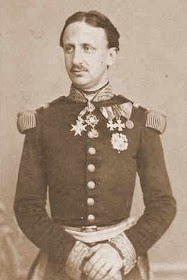Each year I write an e-mail greeting to friends and I thought that this year rather than posting a separate greeting to readers of this blog that I would publish the letter here :
The Votive Painting of Archbishop Jan Očko of Vlašim 1371
Image: Wikipedia
December 2016
Once again Christmas is with us and as usual I find myself writing this letter at the last minute. A friend described it the other year as my Christmas Encyclical. This still seems to be both the easiest way, and also a more informative one, of sending greetings and good wishes for Christmas and the New Year. I do not think I can I amend or add to the text of the letter to make the message slightly more personal at the moment as time is rather against me and in many cases I know I owe a longer letter - which hopefully might get done in January.
I am still living in Oxford. In the past I have written of that as being for good or ill. On the whole it is still very good, as things in this letter will I hope indicate. However some aspects of Oxford life can be tiresome, and as I observed last year things are not always as they once were - a sure sign of age - and that can, and does, induce that negative nostalgia which is not always a very positive thing.
The D.Phil. thesis remains unfinished. As I have said now for several years I still have hopes, one day, of completing my research on Bishop Richard Fleming, and to share my insights and discoveries with others. His life and career provides a fascinating range of insights into many aspects of later medieval life. I have also said previously that I am not one for New Year resolutions as they are usually more observed in the breach than the observance, but that I hoped to get back to the Bishop and some other academic projects. That, alas, has not occurred so far, and who knows whether another year will bring that possibility about. However I do have greater freedom in my routine and calendar than in the past so there may be some hope, and I try to keep myself reading and thinking about the period.
I have also spent time using my historical forensic skills on other topics which attract my attention and that engages my brain in active thought and ( hopefully ) keeps senility away. Those researches might yield something, but then, they might not.
I still work part time at the Museum of the History of Science, but as I fill in the for other staff's absences it is very variable in terms of hours. I have also continued giving tours of Oxford and, on occasion, out to Blenheim Palace. These tours are either directly booked with me or through an independent consortium of guides. The walks I lead may be general ones of the city and colleges or themed ones. The website for my own tours is at http://historicoxfordtours.co.uk : if you or anyone you know who might be interested do get in contact. One meets some very pleasant and interesting people through these tours and I enjoy sharing something of my enthusiasm for the history and traditions of Oxford.
I have also continued with some teaching work with US students, though less than in previous years - which is disappointing - and added to that some teaching for two students at Blackfriars which was intellectually rewarding.
I have also given the first of two lectures on that arms and insignia of Heirs Apparent to my friends at the Oxford University Heraldry Society - the second part is due in February.
I still serve on the Library committee of the Oxford Union, keeping my literary interests engaged and I try my best to to maintain and enhance the History section in particular whenever possible. I am, I suppose, a familiar figure in and around the Union.
I continue to be very grateful for my involvement in the life of the Oxford Oratory as a Brother and regular worshipper. It is a great joy and privilege to participate in such wonderful celebrations of ones faith. I have also spent time at SS Gregory and Augustine here in Oxford, at Blackfriars - including an Ordination there, with one candidate being a former student of mine as I reminded him when I knelt to receive his First Blessing - and, as and when I can, I continue to support the Oxford Ordinariate Mass at Holy Rood as well as a few visits to St William of York at Reading for the traditional rite there - I am always keen to support such celebrations here in Oxford or elsewhere, and served at one at Hethe near Bicester earlier on in the year.
My blog, Once I Was A Clever Boy, takes up quite a bit of time, but this year due to practical time constraints and access to computers - not being on-line at home other than through my mobile phone - I have got very behindhand. Events and ideas have sped ahead of my ability to type and find illustrations. As a result I have a lot of draft posts which only now am I able to complete and publish. I am still on July in terms of posts, but making progress in catching up. Regular readers please bear with me. Those who never bother to look at my efforts - well it makes no difference ( other than diminishing the quality of your lives...). I do enjoy putting the posts together with the background research involved. You can find the blog at onceiwasacleverboy.blogspot.com - and thereby you can follow something of my thoughts and activities. These may well be predictable, but I believe that what I say and record are worthwhile. If you have not so far looked at it, please do, and look back over what I have previously published.
In the summer I was mostly in Oxford with occasional jaunts out or, less than usual, to London but I did join a wonderful Pilgrimage from the Oratory to Westminster Abbey with Mass at the Shrine of St Edward, and there was the Latin Mass Society Pilgrimage to Holywell, including a visit to the priory at Pantasaph, which I last visited in 1958.
In late August I was away on a retreat and holiday with the Brothers of the Oratory at Belmont Abbey on the edge of Hereford. This was an opportunity to participate for a few days in the life of a Benedictine house and also to explore some of the wonderful medieval churches of Herefordshire and Monmouthshire as well as appreciating the spectacular countryside. We were blessed with good weather and that combined with congenial company meant that the whole visit was a wonderful spiritual and mental tonic.
Just afterwards I had another very good day out at Ditchley Park here in Oxfordshire - a fine house built in the 1720s and only open to pre-booked parties - I went with the Heraldry Society.
Last year I wrote that whatever 2016 brought would no doubt be unexpected, and might well be unsettling. Well, I was right there was I not? What a year we have seen. I lay all night in bed listening with increasing amazement and bemusement to the European referendum result, watched our politicians provide us with the most amazing political soap opera of my lifetime in finding a new Prime Minister, and then in November sat up all night at a friend's house watching the US elections.
I will repeat what I wrote a year ago that the world often, too often, seems a violent, troubled and confusing place ( but perhaps it always was and always will be ) and my streak of Yorkshire pessimism gets full rein on many occasions. So many onetime certainties seem unsure, and there seems so little effective direction from many who should provide it, but who appear to bow to every passing breath of opinion and to have no fixed direction. On the other hand 2016 has certainly not been their year. I find comfort in the Catholic faith, in my innate sense of tradition and its value, and in taking the longer view as a historian, and I do wish more people had those insights as a guide.
This year I shall be spending Christmas and New Year with various friends in Oxford.
In myself I think I am keeping reasonably well, and my arthritic joints have got a bit more supple - which as someone who this year reached the pensionable age of 65 is somewhat reassuring!
I continue, as I write every year, to count it a great gift and privilege, indeed blessing, to have so wide and varied a number of so many friends, both old and new. This year has seen new friends added to that group, and that is such a positive sign as one gets older. All these friendships are something in which I rejoice and for which I am ever grateful. It has been a great pleasure to see so many of you through the year, and to be able to spend time with you. It is my most earnest prayer and wish that this will continue and flourish in the future.
Do let me have your news if we have not been in contact recently, and please pass on news of me to other friends.
With every good wish for a blessed, peaceful and happy Christmas and New Year,
John
And now for a short history lesson...
The picture at the top of this greeting is the Votive Panel of Archbishop Jan Očko of Vlašim, Archbishop of Prague. The panel was originally placed in the chapel of Roudnice Castle, which belonged to the bishops and archbishops of Prague who used it as their residence. In 1371 the chapel was consecrated in honour of the Virgin Mary and patron saints of Bohemia, and it was probably then that the picture was finished. It is now in the National Gallery in Prague.
As this past year has seen celebrations of the seventh centenary of the birth of the Emperor Charles IV this seemed a suitable year on which to choose this once again as a Christmas image. It is also an image which links with a number of my historical interests.
In the middle of the upper part the Virgin is enthroned with the infant Jesus. They are adored by the kneeling figures of the Emperor Charles IV and his son King Wenceslaus IV. St. Sigismund of Burgundy stands behind Charles IV, while St. Wenceslaus of Bohemia stands behind the young king as his patron. In the lower part of the panel stand other Bohemian patron saints (from the left): St. Procopius, St. Adalbert,( founder of the see of Prague) St. Vitus ( patron of Prague cathedral) and St. Ludmila (grandmother of St Wenceslaus). In the middle there is kneeling Archbishop Jan Očko of Vlašim (1292-1380), of whom there is a short biography
here who is kneeling before St. Adalbert, his first predecessor as bishop of Prague.












